Best 8 Data Ingestion Tools 2026
Summarize this article with:
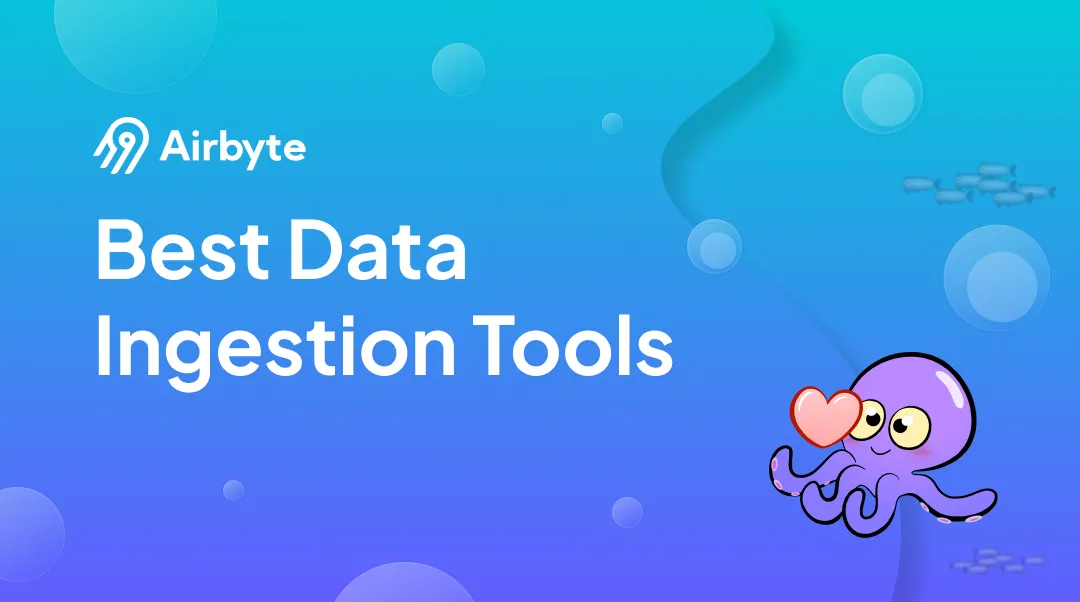

Data ingestion encompasses collecting data from multiple sources and transferring it into another system, helping you create a unified data platform. With a multitude of data ingestion tools making their way into today’s data landscape, selecting the best one may be challenging.
This article will present the top 8 data ingestion tools and their key features. Read ahead to identify the one that aligns best with your preferences and priorities.
What are Data Ingestion Tools?
Data ingestion tools play a vital role in consolidating data from various sources and formats into a centralized repository. You can make use of these tools to unify data from CRM applications and locally stored datasets into a data warehouse. Data ingestion is a crucial process for eliminating data silos. Choosing one of the best tools can help you lay the foundation for advanced data analytics to extract insights and make strategic decisions.
Data ingestion tools typically employ Extract, Transform, and Load (ETL) processes. It allows you to transform data before loading it into your desired destination. Sometimes, these tools also provide you with ELT options where you can transform and standardize your data into the data warehouse after loading it. Both ETL and ELT techniques allow you to automatically adhere to specific data formats, especially when you are consolidating data from disparate sources.
8 Best Data Ingestion Tools
The choice of data ingestion tools depends on several factors. These include specific business requirements, budget constraints, availability of resources, and type and speed of data ingestion needed. Among the myriad options available, here are the top 6 data ingestion tools in the market today.
1. Airbyte
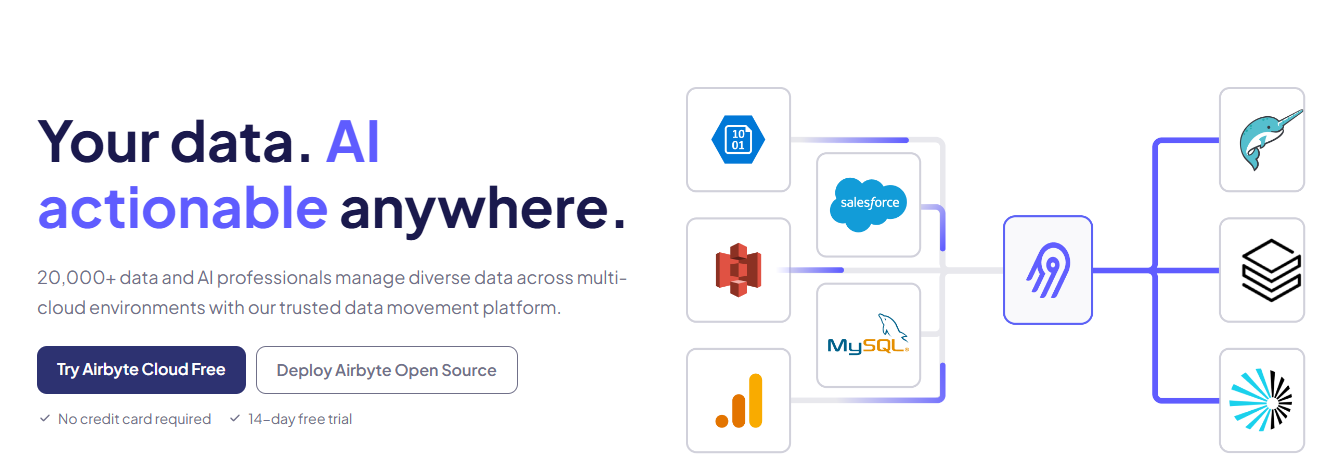
Airbyte is known for being one of the best data ingestion tools. This data integration and replication platform boasts of maintaining one of the most expansive connector libraries. Each month, there are over 1000+ engineers and users who build new connectors, making this tool a one-stop solution for you.
One of the best features of this data ingestion tool is that it offers 600+ pre-built connectors. You can unify data from several different sources and configure the destination in just two simple steps. If you are unable to find a desired platform or application for your dataset, you can turn to their Connector Development Kit (CDK) or Connector Builder to create custom connectors. The data that you transfer through the connectors is not stored or viewable by Airbyte, ensuring top-notch data security and privacy.
Key features of Airbyte:
- Diverse Options to Build Data Pipelines: Airbyte provides various options for developing and managing data pipelines. These include the user-friendly interface, API, Terraform Provider, and PyAirbyte. You can choose the one that aligns with your requirements.
- AI-powered Connector Builder: Airbyte offers an AI assistant to simplify the process of building connectors in Connector Builder. You only have to specify the URL of the API documentation to the AI assistant, and it automatically prefills and configures fields, reducing the development time. It also offers intelligent suggestions to help you fine-tune the configuration process.
- GenAI Workflows: Airbyte supports several popular vector databases, such as Pinecone, Milvus, Weaviate, Chroma, and Qdrant. This facilitates efficient storage and retrieval of high-dimensional vector data, which is essential for powering AI applications.
- RAG Transformations: With Airbyte, you can utilize LLM frameworks, including LangChain or LlamaIndex, to perform complex RAG transformations, such as chunking and indexing. This enables you to improve the accuracy of LLM-generated responses.
- Uninterrupted Data Syncs: Airbyte's checkpointing feature ensures that any synchronization failure caused by a network outage or a system crash can be resumed from the last successful state. This significantly enhances reliability, particularly for large data syncs that take more time to complete.
Enterprise General Availability: The Airbyte Self-Managed Enterprise edition enables you to centralize data access while prioritizing data security. This edition includes advanced functionalities such as multitenancy, enterprise source connectors, role-based access control (RBAC), and sensitive data masking, enabling you to manage multiple teams within a single deployment effectively.
Conduct the data ingestion process by building a robust data pipeline with Airbyte in just a few minutes. Contact our sales team to deploy Airbyte throughout your organization.
2. Integrate.io
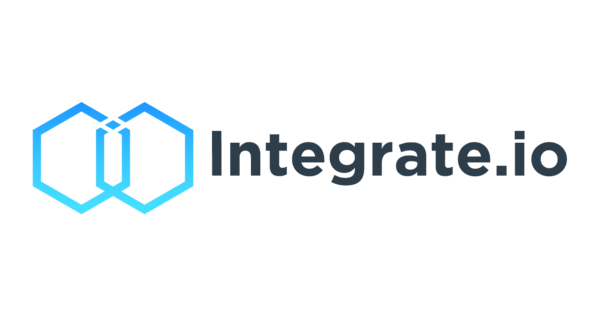
Integrate.io is one of the top cloud-based data pipeline and ingestion platforms. It is designed to facilitate easy extraction of data from several sources and load it into data warehouses or other destinations of your choice. Integrate.io provides you with data transformation capabilities and offers more than 200 built-in connectors to various applications, databases, and APIs.
Key Features:
- Automated Data Transformation: Whether you are building simple, automated packages for data transfer or processing millions of records, Integrate.io ensures high performance through a low-code interface. You can leverage its built-in Python editor for advanced data transformation, too.
- ELT and Reverse ETL Functionality: This top data ingestion tool supports both ELT and reverse ETL functionalities. It allows you to extract, load, and transform the data in formats suitable for analysis. Through reverse ETL, you can transform data from data warehouses and load it into source systems in compatible formats.
Connections with Legacy Systems: On-premise legacy systems are some outdated hardware and software that are still in active use in organizations. With Integrate.io, you can set up a data pipeline with legacy systems and synchronize all your datasets into cloud-based systems.
3. Amazon Kinesis

Amazon Kinesis is a fully managed cloud-based service from AWS. This data ingestion tool can conduct large-scale real-time processing of streaming data from diverse sources, such as websites, applications, IoT devices, and sensors. Kinesis offers seamless integration with various other AWS services and has four major components. These are Amazon Kinesis Video Streams, Data Streams, Data Firehose, and Data Analytics.
Key Features:
- Low Latency: Kinesis can make your streaming data available to multiple analytics applications, AWS Lambda, and Amazon Managed Service for Apache Flink. It achieves this high-speed processing in just 70 milliseconds.
- Security: You can encrypt all your sensitive data in Kinesis Data Streams. To further secure large datasets, utilize the side-server encryption and AWS Key Management Service (KMS) keys.
High Availability: This data integration tool ensures high availability of data by synchronously replicating streaming data across three Availability Zones (AZs) in your chosen AWS Region. It also retains your data for up to 365 days, protecting you against data loss.
4. Matillion

Matillion is a cloud-based data integration and data transformation tool that offers you a comprehensive suite of features. This top data ingestion tool provides cloud-native applications to assist your organization in swiftly ingesting data for analytics and business innovation. The Matillion Data Loader facilitates continuous extraction and loading of data into your preferred cloud data environments.
Key Features:
- ETL API: The Matillion ETL API is accessible via standard REST-based APIs. It utilizes HTTP or HTTPS requests to conduct operations, such as GET, POST, and DELETE. This data ingestion tool’s API also facilitates high volume data transfers through Uniform Resource Identifiers (URI).
- Job Scheduler: Matillion provides you with a job scheduler that prompts the automatic launch of orchestration jobs at predefined intervals. To execute your scheduled or queued jobs, you must enable the platform's ETL instance. With the job scheduler, you can even set up multiple schedules against different projects.
Change Data Capture: This data ingestion tool accelerates your data productivity by capturing all changes within your database. You can track data modifications without impacting your data pipeline’s performance.
5. Apache Kafka

Apache Kafka is one of the top versatile open-source tools for constructing high-performance data pipelines and managing data ingestion processes. The platform can cater to the diverse needs of your business by providing you with real-time data processing and analytics. You also benefit from a vast open-source community that helps you enhance the overall data ingestion performance.
Key Features:
- Kafka Connect: Kafka Connect is a tool that facilitates quick data streaming between Apache Kafka and external systems. It enables the ingestion of your databases and application server metrics into Apache Kafka for batch systems as well as real-time data streaming.
- High Throughput: One of Kafka’s core capabilities is delivering high data throughput that exceeds 100s MB/s. This data ingestion tool can handle hundreds of data records per second with remarkably low latency.
Persistent Logs: Kafka maintains a persistent log, allowing you to read, retain, and retrieve data for an indefinite period. You can use this fault-tolerant stored data for further analysis in the future.
6. Apache NiFi
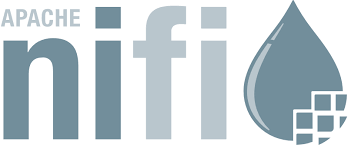
Apache NiFi is one of the top data ingestion tools known for its extensive configurations, security measures, and scalability. This open-source platform can reliably process and distribute large volumes of data, making it an ideal choice for organizations seeking efficient data management solutions.
Key Features:
- Data Provenance Tracking: Apache NiFi offers detailed data provenance tracking, allowing you to trace every step of your dataset’s journey. You can see when your data was extracted, joined, cloned, modified, and eventually transferred to its configured destination all at once.
- DataFlow Templates: This data ingestion tool helps you construct intricate DataFlows using fundamental components. These include Processor, Funnel, Remote Process Group, and a few more core parts. NiFi also provides you with templates that utilize the basic DataFlow elements to create larger constructs that can be reused and shared as XML files.
Build Processing Pipelines: Apache NiFi offers a flexible framework for building processing pipelines, incorporating both standard and custom components. The platform supports ExecuteProcess and ExecuteStreamCommand for running operating system commands. You can also execute custom code in different programming languages to build your own pipeline.
7. Fivetran
Fivetran is a fully managed data integration platform built for analysts and engineers who want to focus on analytics rather than pipeline maintenance. Known for its zero-maintenance architecture and reliability, Fivetran offers automated schema management and connectors that adapt to source changes with minimal human intervention.

Key Features:
- Prebuilt Connectors: Fivetran provides 400+ fully managed connectors for databases, SaaS apps, and event streams, all designed to update data in near real-time.
- Schema Drift Handling: Fivetran automatically detects changes in source schema (e.g., added or removed columns) and adjusts the pipeline accordingly, reducing the need for manual oversight.
- Data Governance: With role-based access control, column-level lineage, and SOC 2 compliance, Fivetran ensures secure and governed data movement across platforms.
8. Hevo Data
Hevo Data is a no-code data pipeline platform built for real-time data ingestion from over 150 sources. It’s designed for fast deployment and ease of use, making it ideal for data teams that want to reduce engineering bandwidth and get insights quickly.
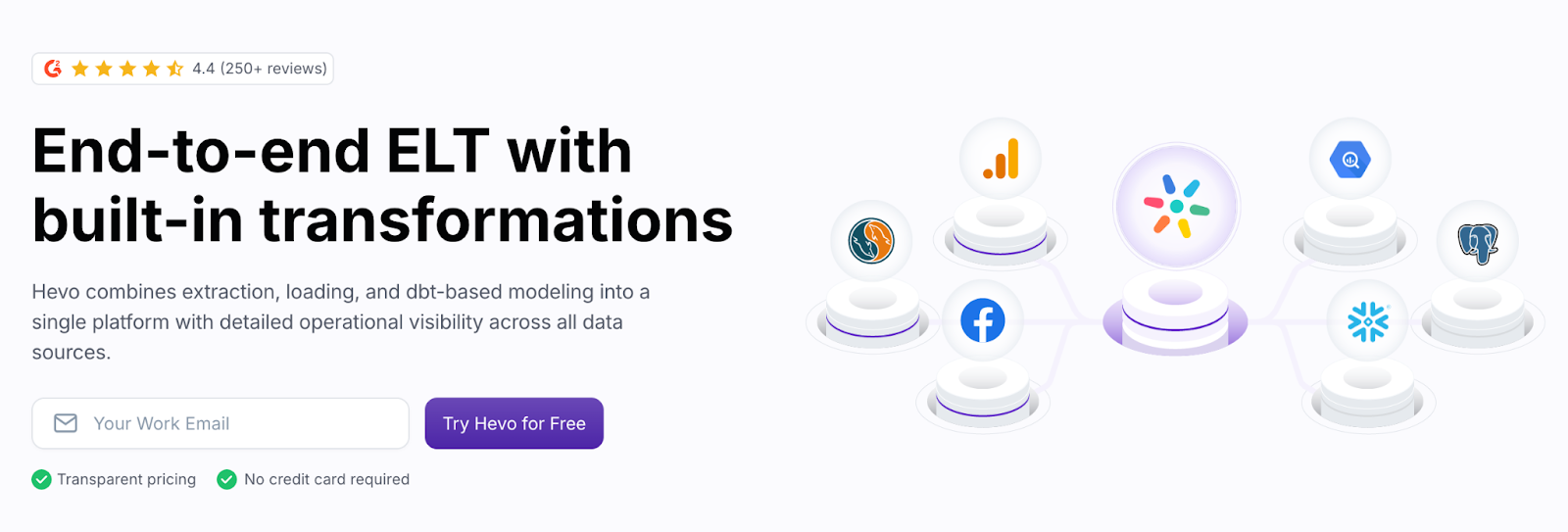
Key Features:
- Real-Time Data Streaming: Hevo enables real-time ingestion and replication into data warehouses like Snowflake, BigQuery, and Redshift.
- No-Code UI + Auto Schema Mapping: Users can set up data pipelines without writing any code. Hevo also automatically maps schema changes from source to destination.
- Error Handling and Monitoring: Hevo includes built-in observability tools like live pipeline monitoring, alerts, and failure resolution support.
Things to Consider When Choosing a Data Ingestion Tool
- Source and Destination Support
Ensure the tool supports all your required data sources (like databases, APIs, SaaS apps) and destinations (such as data lakes or warehouses). Look for pre-built connectors and custom connector options. - Real-Time vs. Batch Processing
Decide whether your use case needs real-time streaming or scheduled batch ingestion. Tools like Amazon Kinesis and Kafka support real-time use cases, while Airbyte and Fivetran are ideal for batch processing. - Scalability and Performance
Choose a tool that can grow with your data needs. It should handle large volumes efficiently, support parallel processing, and offer features like checkpointing or incremental sync.
Data Transformation Capabilities
Some tools offer built-in ETL or ELT features, allowing you to clean, map, or enrich data during ingestion. This can simplify downstream analytics and reduce the need for separate transformation tools. - Security and Compliance
Make sure the tool meets your security standards, with features like encryption, access control, and compliance with GDPR, HIPAA, or other relevant regulations.
Conclusion
Data ingestion tools are indispensable in modern data integration roles as they help streamline the transfer of large datasets. They assist you in setting up a robust ingestion pipeline for data management, saving time and effort. Using a top data ingestion tool is a foundational step in the data analytics process. You can also monitor and enhance the quality of your data with these tools, thereby adhering to privacy and security standards.
Simplify the selection process by choosing one of the best data ingestion tools, Airbyte. Sign up for free and get started right away!
1. What is the difference between data ingestion and ETL?
Data ingestion is the process of collecting and moving data from various sources into a central repository, such as a data lake or data warehouse. ETL (Extract, Transform, Load) is a broader process that includes data ingestion (extract and load), but also transforms data before loading it. While all ETL processes involve data ingestion, not all data ingestion pipelines perform transformation.
2. What are the types of data ingestion?
There are mainly two types of data ingestion:
- Batch ingestion: Data is collected and transferred in scheduled intervals (e.g., hourly, daily).
- Real-time ingestion: Data is collected and transferred instantly as it is generated, enabling real-time analytics. Some platforms also support micro-batching, which processes small batches frequently for near-real-time performance.
3. How do data ingestion tools ensure data reliability during transfer?
Reliable data ingestion tools use features like checkpointing, error retries, and incremental syncs to prevent data loss or duplication during transfers. These tools often track the last successful sync and resume from that point in case of failures, ensuring data integrity even during crashes or network interruptions.
4. What are the key features to look for in a data ingestion tool?
Important features include:
- Support for multiple data sources and destinations
- Real-time and batch processing capabilities
- Built-in or customizable transformation support
- Monitoring, error handling, and alerting
- Security and compliance (e.g., encryption, RBAC, data masking)
- Scalability to handle increasing data volume
5. Can I ingest data from on-premise systems to the cloud?
Yes. Many data ingestion tools like Airbyte, Integrate.io, and Fivetran offer connectors that support on-premise systems, allowing you to move data securely to cloud-based storage or analytics platforms. It's essential to check if the tool supports your legacy systems and complies with security policies during the migration.
Suggested Reads:
What should you do next?
Hope you enjoyed the reading. Here are the 3 ways we can help you in your data journey:



Frequently Asked Questions
What is ETL?
ETL, an acronym for Extract, Transform, Load, is a vital data integration process. It involves extracting data from diverse sources, transforming it into a usable format, and loading it into a database, data warehouse or data lake. This process enables meaningful data analysis, enhancing business intelligence.
This can be done by building a data pipeline manually, usually a Python script (you can leverage a tool as Apache Airflow for this). This process can take more than a full week of development. Or it can be done in minutes on Airbyte in three easy steps: set it up as a source, choose a destination among 50 available off the shelf, and define which data you want to transfer and how frequently.
The most prominent ETL tools to extract data include: Airbyte, Fivetran, StitchData, Matillion, and Talend Data Integration. These ETL and ELT tools help in extracting data from various sources (APIs, databases, and more), transforming it efficiently, and loading it into a database, data warehouse or data lake, enhancing data management capabilities.
What is ELT?
ELT, standing for Extract, Load, Transform, is a modern take on the traditional ETL data integration process. In ELT, data is first extracted from various sources, loaded directly into a data warehouse, and then transformed. This approach enhances data processing speed, analytical flexibility and autonomy.
Difference between ETL and ELT?
ETL and ELT are critical data integration strategies with key differences. ETL (Extract, Transform, Load) transforms data before loading, ideal for structured data. In contrast, ELT (Extract, Load, Transform) loads data before transformation, perfect for processing large, diverse data sets in modern data warehouses. ELT is becoming the new standard as it offers a lot more flexibility and autonomy to data analysts.

.webp)